Cherished fells
The Lake District fells hold the power to shape lives. We asked a handful of friends to describe how they have been influenced by a specific peak. Words by John Manning.
Wainwright archivist Chris Butterfield – Castle Crag
The fell that means most to me? Castle Crag, without a doubt.
I first climbed it in 2011 with Priscilla, then my girlfriend – we’d been together for 18 months and it was our first time in the Lakes together. It was the first of many fells we went up that week, but nothing else connected like Castle Crag.
It was a balmy summer’s day, and we explored the summit for what seemed like 90 minutes but was, we later realised, nine hours. Nine hours! How many fells can you spend nine hours on? For a long time we just sat on the grass facing Derwent Water as people came and went. When evening drew in, we didn’t want to leave; only the fading light forced us down.
This all happened a couple of years before I became aware of Alfred Wainwright, and five years before I started archiving AW’s work. On reflection I suppose it was our ‘Orrest Head moment’.
There was something about Castle Crag that day – a connection we still can’t explain. It’s not always the highest fells that connect; sometimes it’s the unassuming locations with which we form a bond. Look at Wainwright’s choice of Haystacks, for example, as the place he wanted his ashes scattered.
I’ve been up Castle Crag with Priscilla – now my wife – several times since that 2011 ascent, and each time it’s been very special for us. As a couple we’ve done a lot since. We’ve walked hundreds of miles on long distance paths, and we’re well on our way to completing the Wainwrights. But nothing has resonated in the same way as that first walk up Castle Crag.
To mark the 70th anniversary of the publication of The Eastern Fells – the first of Alfred Wainwright’s seven volume Pictorial Guide to the Lakeland Fells – Chris has co-curated a new exhibition at The Armitt in Ambleside, which opens on Wednesday, 12 February, and runs until 20 December.
Guidebook author Vivienne Crow – High Pike
High Pike. Always and without a doubt. God knows how many times I’ve been up there.
High Pike is one of the closest fells to our home. The southern Lake District is an hour-and-a-half drive from Carlisle, but Caldbeck and Hesket Newmarket are only a half hour away. When time’s tight or the weather’s set to deteriorate, we always say: “Let’s go up High Pike!”
I’ve tried to count the number of times I’ve been up there, but I had to give up; it might be three figures. When friends who’re not fell-walkers come to visit, if someone’s recovering from an illness or an injury, or if the weather’s bad and we’ve got to get out the house, it will be High Pike.
I love chatting to people up there, helping them understand what they’re looking at: you can see into the Lake District proper, but there’s Scotland, too, and you can look out across the North Pennines. If the outlook is particularly clear you can even see the Cheviot in Northumberland.
High Pike took on a special significance in September 2006 after me and my partner [author Heleyne Hammersley] had our civil partnership at the registry office in Carlisle. Some people do the formal thing, but our ceremony was a casual, middle-of-the-week affair. Afterwards a bunch of us headed up High Pike and opened a bottle or two of champagne. We actually wore our walking boots to the registry office so we were ready to go straight up afterwards.
The second edition of Viv’s Lake District: High Level & Fell Walks was published by Cicerone last year. www.viviennecrow.co.uk
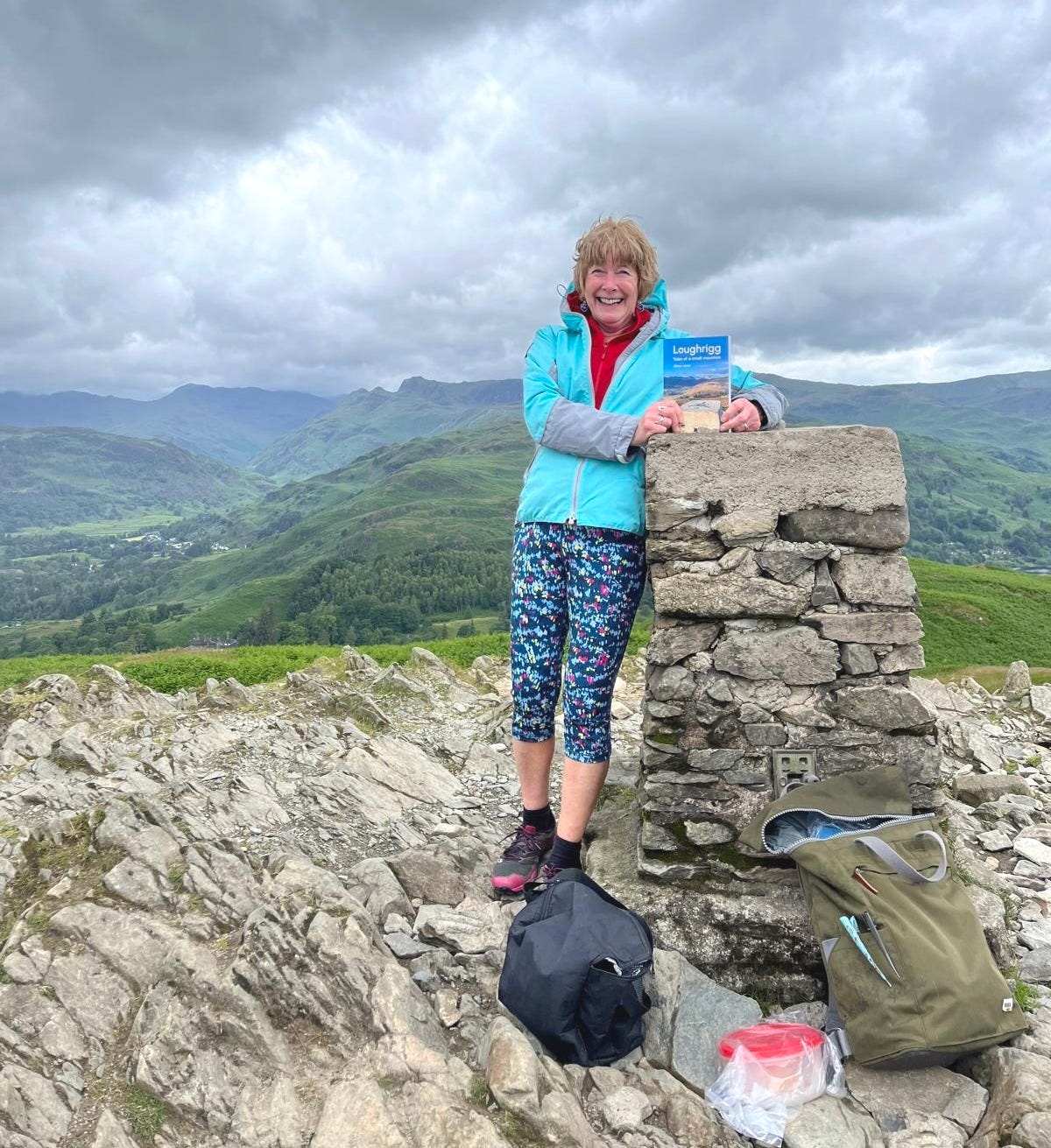
Author Eileen Jones – Loughrigg
I was engaged, briefly, to a chap who was not right for me. As my birthday approached, he asked what I’d like to do (he had a car and I didn’t), and I told him I’d love a day in the Lakes. So he drove us to Ambleside, where he parked on the Loughrigg road near the cattle-grid, took the Sunday papers out and sat reading them while I went for a walk on Loughrigg. I thought then: “This isn’t going to work”, and when he took me home I returned the ring. From then on, I knew my love for the Lakes overcame everything else.
Loughrigg is more than a favourite fell. It is that, but it’s far more.
I lived in Hebden Bridge for a long time and dreamed that one day I’d live in the Lakes. It was more than a daydream; if I couldn’t sleep, or woke in the night worrying about something, I would have this picture in my mind, of running over Loughrigg’s hummocky little paths.
I moved to the Lakes in 2010 and started exploring every facet of Loughrigg – going up there on average once a week – sometimes walking with visitors or my kids, but mostly running it. Two years on, I was running back from the summit one day and I realised: “I’m living my Hebden Bridge dream!”
Lockdown in 2020 was awful. All of my work dried up. But at least I had my hill to wander over, and I had time to explore it more – to take paths I’d never discovered before. I could still get lost on it, too – it’s such a sprawling, magnificent hill.
During those locked-down days, Loughrigg became a talisman; my touchstone when times were tough. If I could only ever go up Loughrigg for the rest of my days, I would be content.
The launch party for Eileen Jones’ book, Loughrigg: Tales of a Small Mountain, was held on the summit of Loughrigg on a wet summer’s day in 2024.
Cabinet maker Richard Jennings – Ullscarf
Most people regard Ullscarf – the most central fell as the crow flies – as one of the most boring fells in the Lake District. But it evokes special memories for me.
When I was still new to walking and hiking I joined an online discussion group – the Walkers’ Forum – way back in 2009, in the early days of internet groups.
Forum member Dave Clapham, who went by the name ‘Lakesnut’, made me feel welcome – and embraced me, as a fellow Yorkshire lad – right from the start. I wasn’t driving at the time, so I used to travel from Barnsley to Wakefield, then catch a train to Leeds, where he lived, and he’d drive me up to the Lakes. That was my introduction to the Lake District.
Dave was my mentor – and, having the wheels – my enabler. There was plenty of banter as we walked, but most of all exploration. We did things we probably shouldn’t have done; he had this idea of leaving the path and heading up ghylls that no-one had climbed before – he’d point to a ghyll and say: “Right, let’s go up there.”
That was how we came to be scrambling up Cat Gills. Cat Gills was one of the first ghylls we explored together, only for us to arrive on Ullscarf’s summit plateau. That ascent line turned the Lakes’ most boring fell into the most exciting day out – and that exemplified Dave’s approach to life.
Dave was funny, kind and the best friend I had, but he suffered with depression for many years. He took his life in 2015.
Dave inspired me to wander off the beaten track, to explore the hidden gems of the Lakeland fells. To this day I still like to wander off-piste on my own, where I stop to think about Dave.
Richard has devised the 144-mile, 12-day Lakeland Way walking trail around the Lake District National Park.
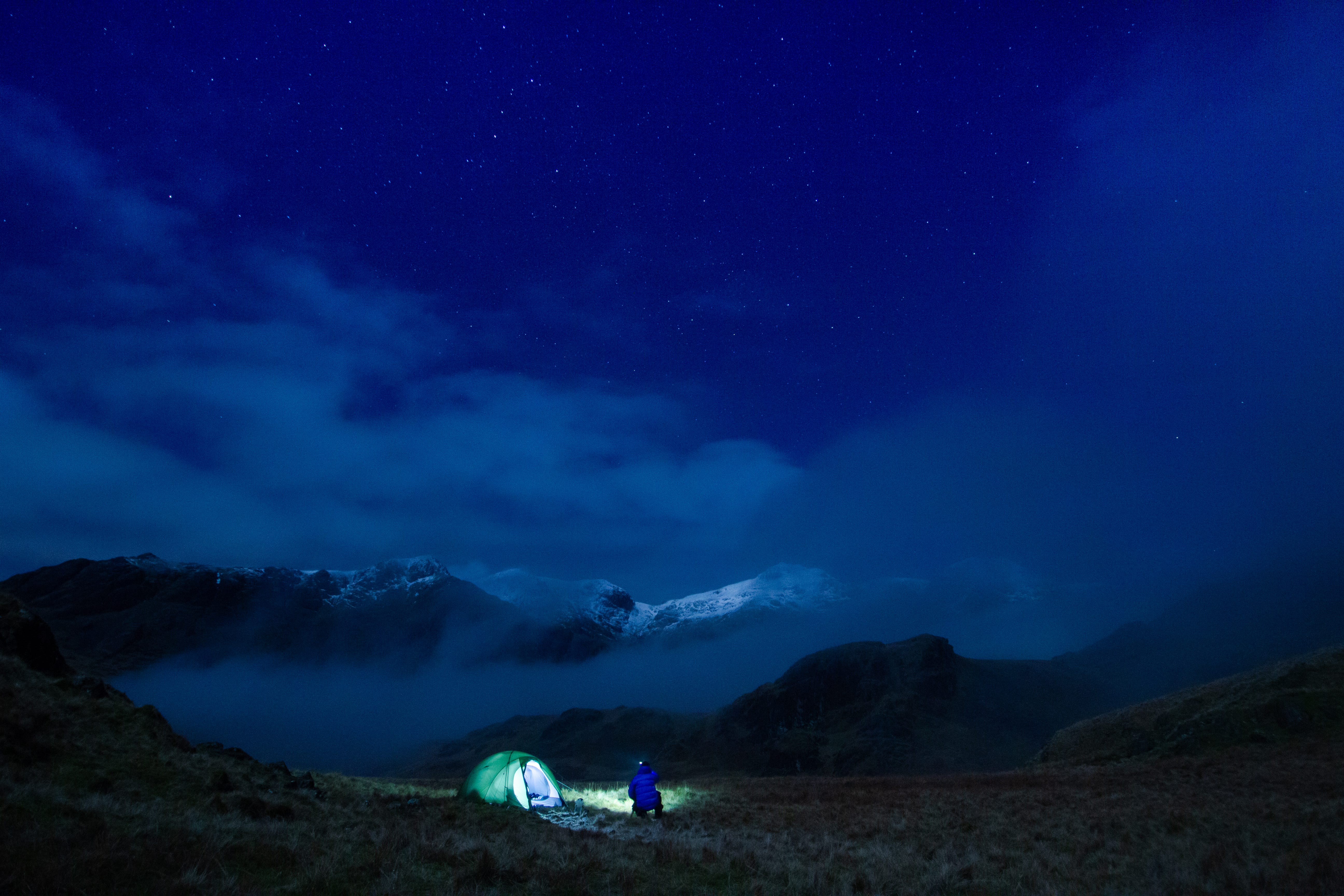
Film-maker Terry Abraham – Scafell Pike
There are a few places in the Lakes that I regard as special – it very much depends on the time of year and the season – but in winter it’s Scafell Pike.
That’s mostly to do with my first Life of a Mountain documentary, because I practically lived on and around Scafell Pike in a tent for nearly two years while making it. I got to know every inch of the fell. Being out there in all weathers and getting to see so many magical moments means the fell will always hold a special place in my heart.
When you get to know a hill like that it takes on a character – a personality. I often describe Scafell Pike as “an ugly prince”. From Wasdale it looks like a series of scruffy hills with craggy knobs on top, but when you go to the other side – into Great Moss – you see its majestic ‘princely’ face, defined by towering rocks and cliffs, gullies and ghylls. Not many people venture into Upper Eskdale and appreciate that side of it because they come up from Langdale, Borrowdale or Wasdale. Scafell Pike’s true nature is its hidden, majestic façade.
When I’m up there in the fog, I know where I’m going. I haven’t used a map on the fell for years. More often than not I’m off-piste, and there’ll be certain boulders, certain shadows, certain lichen on rocks that act as a guide.
Views are always special to me, as is peace and solitude, and what’s going on in the landscape. But it’s also about people. I hope that shows in my work. Those people are shaped by the environment. You often see happiness surveys, and Cumbrians are regularly identified as some of the happiest in the country. I think that’s to do with the landscape we’re lucky to live in.
Life of a Mountain film producer Terry Abraham’s latest documentary Cumbria’s Red Squirrels, which highlights the plight of the iconic creature, has been shortlisted in the Broadcast Factual and Cinematography categories of the North East and The Borders Royal Television Society’s 2025 Awards. More from Terry: www.terryabraham.com
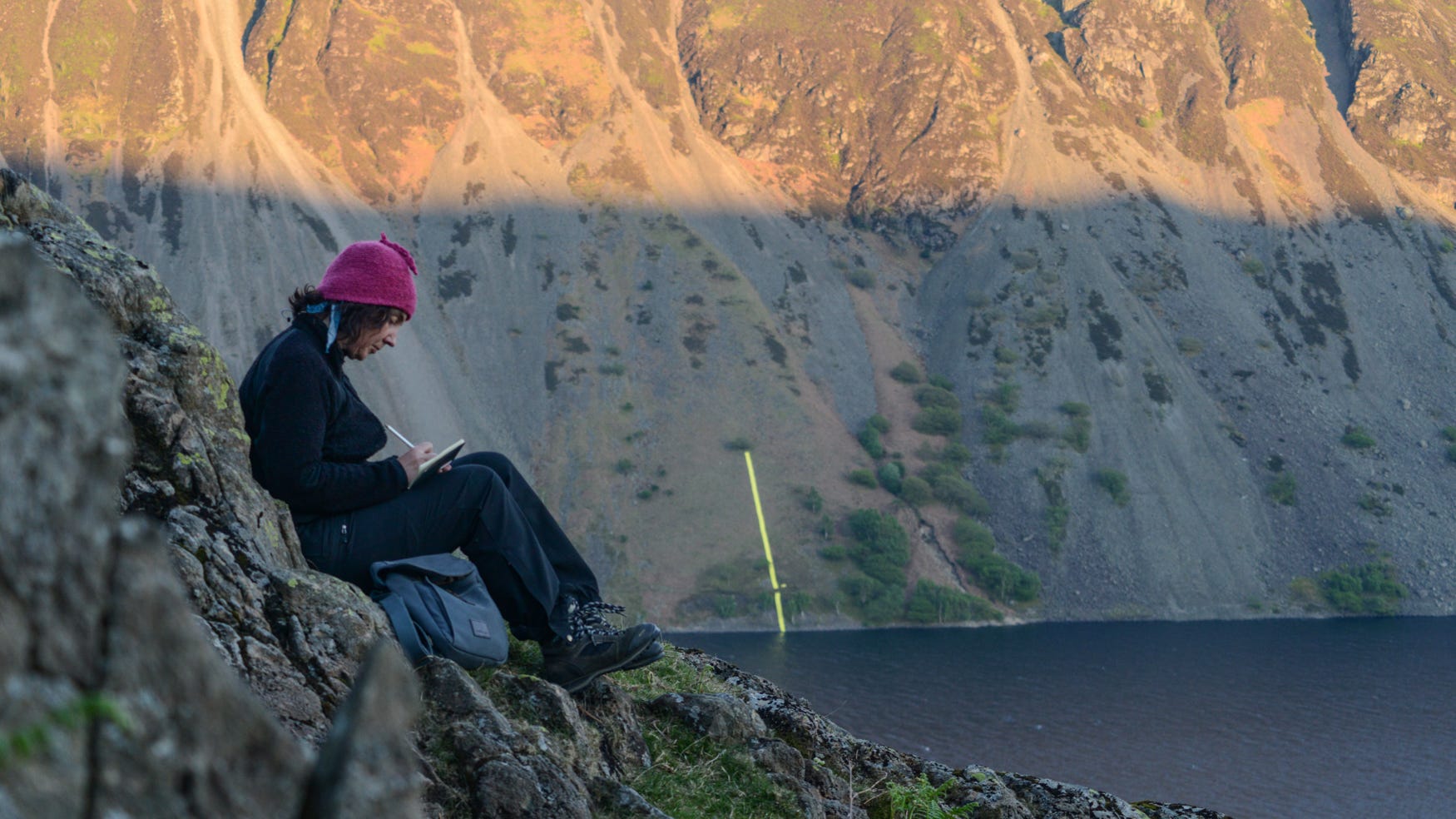
Artists Harriet and Rob Fraser – Middle Fell
Rob: Middle Fell, on the western shore of Wast Water, set us on the path for the art that we’re making now.
When we did The Long View, back in 2015–2017, we intended to create a ‘colour intervention’ at each of seven featured trees spread across Cumbria. The first was at the Wasdale Oak, on the Wast Water screes. With the necessary permissions from the landowner – the National Trust – and the grazier, we placed a 110-metre yellow line from the Wasdale Oak down to the water itself (pictured above). That yellow line carried a poem.
Harriet: The poem, titled ‘Everything is Connected’, was printed in large letters, which could only be read if you were next to it. That was the first time we used poetry in an outdoor installation, so it was a key moment for us.
Rob: When the yellow line was installed, Harriet and I climbed onto Middle Fell to view it from a distance. The bright dash of yellow on the Screes was a remarkable presence in the landscape. Sitting there in the gloaming was quite a moment for us.
Harriet: The view from Middle Fell – looking across Wast Water towards the Screes and out towards the west coast – is staggering, and the light that night was amazing. This artwork began a conversation about human presence in the landscape. So many people love the Lake District, but this asked about our touch on the land as human beings. The line had to be cut in the middle to make way for the footpath, which offered a metaphor about the connections that exist naturally between trees, earth and water, that we humans sometimes cut through for our own good.
The instillation was only in place for six days, but it created a conversation: about where art should be; about what art can provoke in terms of reflecting on our place in the land; and how the places we love mean different things to different people in terms of ownership and love. Some people were put out by it and some loved it.
Oh, and Wasdale also holds a special place in our hearts because we were married on the lakeshore – in the grounds of the youth hostel, though, not on the screes!
Rob and Harriet’s environmental art and research project Somewhere-nowhere encompasses photography, poetry, art, walking and research.
Author and rambler Chris Jesty – Scafell Pike (1978)
I am more familiar with Scafell Pike than any other mountain.
I can’t say that I like it better than any other – I prefer lower hills and the outlying fells – but Scafell Pike is special because I spent so much time on it while producing a panoramic guide to the view from its summit. I devoted three and a half years to the project and lived in a tent on Scafell Pike for six weeks in 1974.
The first panorama I produced was for Snowdon. I sent a copy to Alfred Wainwright, ostensibly to see if I’d got the Lakeland mountains correct, but really to show him what I’d done.
He was impressed, and suggested I should sketch the mountains in, like he had with his books. I replied that I was no good at that, so we decided I would make another outline panorama, of the view from Scafell Pike this time, and he would sketch in the mountains.
During those six weeks camping, I started off at Hollowstones, but wanted to be able to reach the summit in less time, so I moved to Broadcrag Tarn, and then up further onto the south summit. When it was raining – and it rained a lot – I sat in the tent. I also spent three months living with Joss Naylor in his farmhouse. I didn’t get as much clear weather on Scafell Pike as I would have liked, though I did get a glimpse of Ireland, and the highest mountains of Snowdonia.
I drew outlines of those distant hills from sketches made in the field and from the hundreds of slides I took, then I wrote the accompanying text. When I was done, Wainwright filled the mountains in detail.
I only met Wainwright once. I had a cottage in Dolgellau which he rented while he was working on Welsh Mountain Drawings [1981] and the North Wales Sketchbook [1982]. I needed to collect a number of panoramas from the cottage while he was there, and that was when I met him. He was easy to get on with, and nice to talk to. I didn’t know him well, but he was like me – we both expressed ourselves best by writing.
As well as writing a number of walking guides and mountain panoramas, Chris Jesty is best-known for revising Alfred Wainwright’s Pictorial Guide to the Lakeland Fells and other pictorial guidebooks. www.chris-jesty.co.uk
Author Pete May – The Langdale Pikes
The Langdale Pikes were the first fells I climbed way back in 1977 when I was 16 and on an A-Level geography field-trip.
It was the first time I’d seen the Lake District and, coming from the flat lands of Essex, it was an epiphany. I remember scaling the path from the Old Dungeon Ghyll Hotel and encountering scree slopes, rocks and tumbling water. I couldn’t believe this place existed.
My dad was a farmer, based between Romford and Brentwood, and I’d always enjoyed solitary wanders around local fields and woods. But that was a flat landscape, which meant the mountainous Langdales came as a complete contrast.
I was walking in Dr Marten boots and a moped over-suit as waterproofs, and I remember sitting down for lunch at Stickle Tarn, with the mass of Pavey Ark behind it. Looking up past the rocks, the vast sky and sound of falling water all struck me.
We were studying Wordsworth in A-level English at the time and I suddenly saw what he was writing about – that unity between Man and Nature. It was an emotional moment. We only went up to Stickle Tarn, then round to Easedale Tarn and down into Grasmere, but it opened my eyes. The Langdale Pikes still trigger that sense of awe in me – that, ‘Wow, I never knew this existed’ feeling.
I recall that A-Level hill trip every time I return to Langdale. I still see a few old classmates – they remember the laughs and illicit beers in the hotel bar in Grange-over-Sands – but I don’t know whether the experience affected them in the same way it did me.
Pete May is the author of Wainwright bagging memoirs Summit for the Weekend and Man About Tarn, both of which are available from Amazon or from his website. www.petemay.org.uk.
Litter picker Lindsay Buck – Scafell Pike
Explaining why Scafell Pike means so much to me – and why I litter pick there daily – is easy: I love Wasdale; I love the western part of Cumbria I call home; and the Pike is England’s highest war memorial.
Scafell Pike attracts a huge number of people each year, most of whom are brilliant and look after it, but some who leave a mess. It is really important that it’s shown respect, so as I’m lucky enough to live just down the road – and as I’m going up there anyway – there’s no reason not to do something good as I walk.
Any popular place that stays clean does so only because someone’s doing something about it – it’s one of the few times where you can do something and immediately see a difference. That means I always carry a bag and a pair of gloves when I head out.
Picking up rubbish helps normalise the behaviour, so that everybody can think about doing it, rather than thinking how amazing it is that somebody else does it. Jo Balmer, who runs the Barn Door Shop at the head of the valley, nicknamed me the Wasdale Womble…
My husband, Jim Davis, is incredibly supportive. If he doesn’t come up with me, he’ll go to Wasdale Green and collect stuff, so while it’s my obsession, it’s a joint effort. Locally, there’s also Gord Ritson and Mick Pearce who climb the Pike frequently, and there are ladies looking after the lakeside and villagers who each tidy a patch of roadside. Together they’ve made a noticeable difference over the last five years.
Early summer mornings are particularly special. I cycle up the valley, and the wildlife is stunning. I’ve seen red deer, roe deer, badgers, foxes, hares, barn owls, tawny owls…
The fell is different every day. In the last week I’ve had a near-white-out, I’ve had an inversion, I’ve had clear weather, I’ve had rainy weather… I’ll never get fed up with it.
Fell-running Wasdale Womble Lindsay Buck litter-picks on Scafell Pike most days, and occasionally fund-raises for Wasdale Mountain Rescue Team.
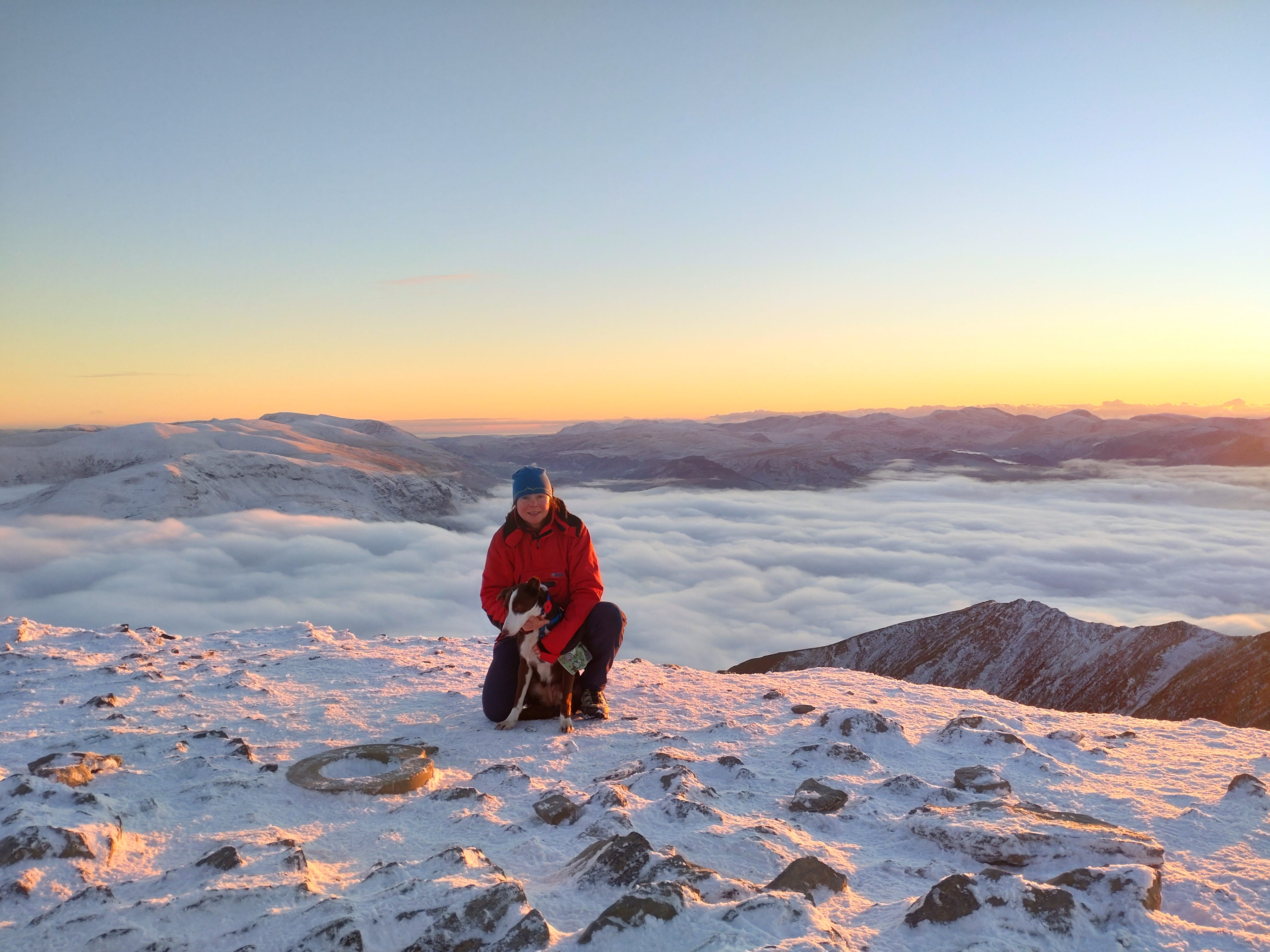
Rescue dog trainer Elly Whiteford – Blencathra
Blencathra is what I see every morning when I open the curtains. I’ve been up zillions of times. It’s beautiful, big and wild.
I grew up in the Northern Fells, between Hesket Newmarket and Mungrisdale. As a kid we had TV time rationed, so we’d cycle over to Mosedale below Carrock Mine, instead, and swim in a pool there. Friends up the road would let me ride their fell pony, Flash; I’d search the fell with a halter and lead until I could catch him.
My family was into hillwalking and birdwatching. Dad used to discuss the geology and the mines on Carrock Fell, West Fell and High Pike. That was a big influence when I chose my degree subject: geology with applied geology. I went on to do a masters at Lancaster, and now work with the Environment Agency. Outside of work I train rescue dogs and am a member of Keswick Mountain Rescue.
There are so many ingredients that influence a person’s life. The Northern Fells have been pivotal in so many of my life choices.
Over the years I’ve done a few searches on Blencathra with the rescue team – often for someone who's not come home.
We had a call for a missing walker one April years ago, which turned into the only time I’ve lost a dog on a search. I and another team member, with my Border collie Meg, were tasked with working up Scales Fell to the summit and under Foule Crag. The clag was down, there were snow patches on the ground and Meg was ahead of me wearing a bell so I knew where she was. As we neared the ridge we went into a howling gale with thick clag; my torch light was bouncing back off the cloud and suddenly I couldn’t see or hear her. We went towards the summit but couldn’t see prints in the snow, so we dropped back towards the tarn, where we’d last seen her; nothing. We waited and called; nothing. I became increasingly worried because of the big drops around there.
I finally got a radio call from Mousthwaite Comb to say Meg had been seen running around frantically. When I got there she came up, panting madly, traumatised because she been unable to pick up my scent. It was an experience I never want to go through again.
I watch Blencathra year-round, and how it changes. In late summer, with the heather, it shimmers purple as flocks of birds drop in and out of the cloud. I’ve skinned up and skied off a few times, and done winter rescue training with one of my dogs there.
Blencathra’s got so many variants: its steep face, its ridges, the glaciated truncated spurs across the front, the open, rolling wilderness at the back… It’s the definitive Lakeland mountain.
Elly Whiteford, the Lake District Mountain Rescue Search Dogs Association’s training officer, is also a member of Keswick Mountain Rescue Team and is training her fourth dog, Dash, an air-scenting border collie.
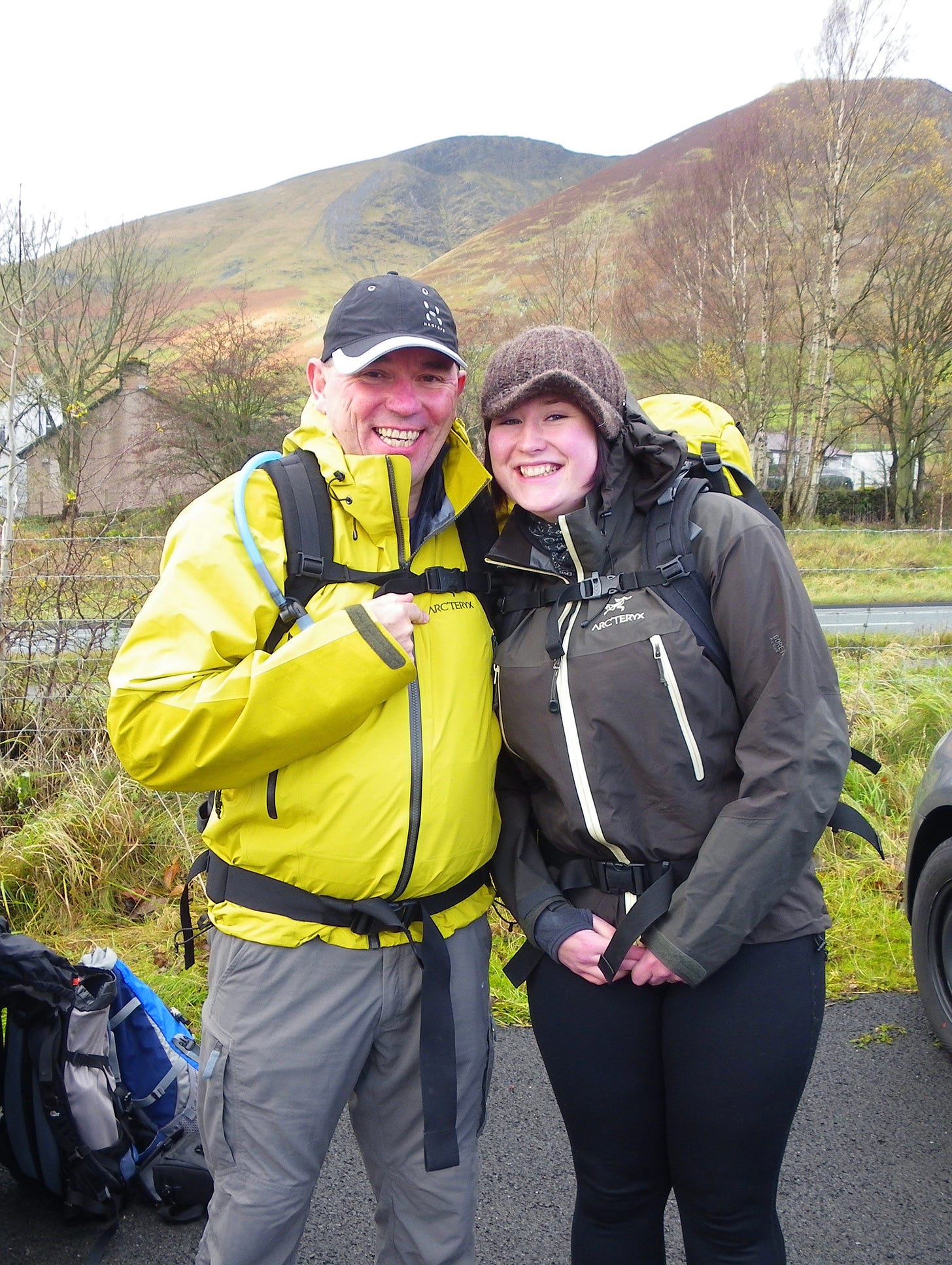
Campaigner Andy Airey – Blencathra
Blencathra has always played an important role in my life.
My mum and dad had Threlkeld village shop when I was younger, and the Horse and Farrier in the 1970s, so all my growing up was done in the village. That view of Gategill Fell – we call it Dan Fell – with Knott Halloo on the top was the backdrop of my youth.
As lads, Blencathra was our playground. If we weren’t playing football or cricket, or messing around in the becks, we’d be on the fell, so it was etched into my brain from birth. It’s a bloody wonderful fell, with those edges, and those views…
We lost my daughter, Sophie, to suicide in 2018. It was earth-shattering, and it still is shattering, six-and-a-bit years later.
When we came to scatter Sophie’s ashes we asked ourselves: “Where’s right? Where would she appreciate? And where would be right for us?”
Blencathra came to mind, though not the summit. In the end we chose a place on Gategill Fell – and, again, not the top.
The choice harked back to a walk we did four or five years before she died. Me and my wife Fiona went up Blencathra with Sophie and her brother, Gregor. Sophie would usually stride out ahead but, but for whatever reason on this occasion she and Gregor were trailing along at the back while Fiona took the lead. It was a tough ascent up Gate Gill, and we all ended up laughing about the unpleasantness of the walk as we sat on Knott Halloo, looking down over the village. Then we walked to the top along that ridge few people walk. It was a very special day.
Sophie’s final resting place looks over Threlkeld, onto the house in which I was born near the Village Hall. There’s the pub where I grew up, and there’s the house where my mum and dad lived after they came out of the pub, at Townhead, above the school. When Sophie was in pre-school, she spent a lot of time there.
Now, when I go to Threlkeld, or drive past on the A66, I always look for that place on the hillside. It’s a really nice reminder of the times we spent – not just on Blencathra but all the times we spent outside with Sophie – and the great joy she brought to us when we were out walking, biking or whatever.
Andy Airey, together with fellow bereaved fathers Tim Owen and Mike Palmer – known as the 3 Dads Walking – were made Members of the British Empire (MBE) in 2024 for their ongoing campaign to have suicide prevention made a compulsory part of the schools’ curriculum, and to raise awareness of suicide among young people. Their book, Three Dads Walking: 300 Miles of Hope, is available on Amazon. www.papyrus-uk.org





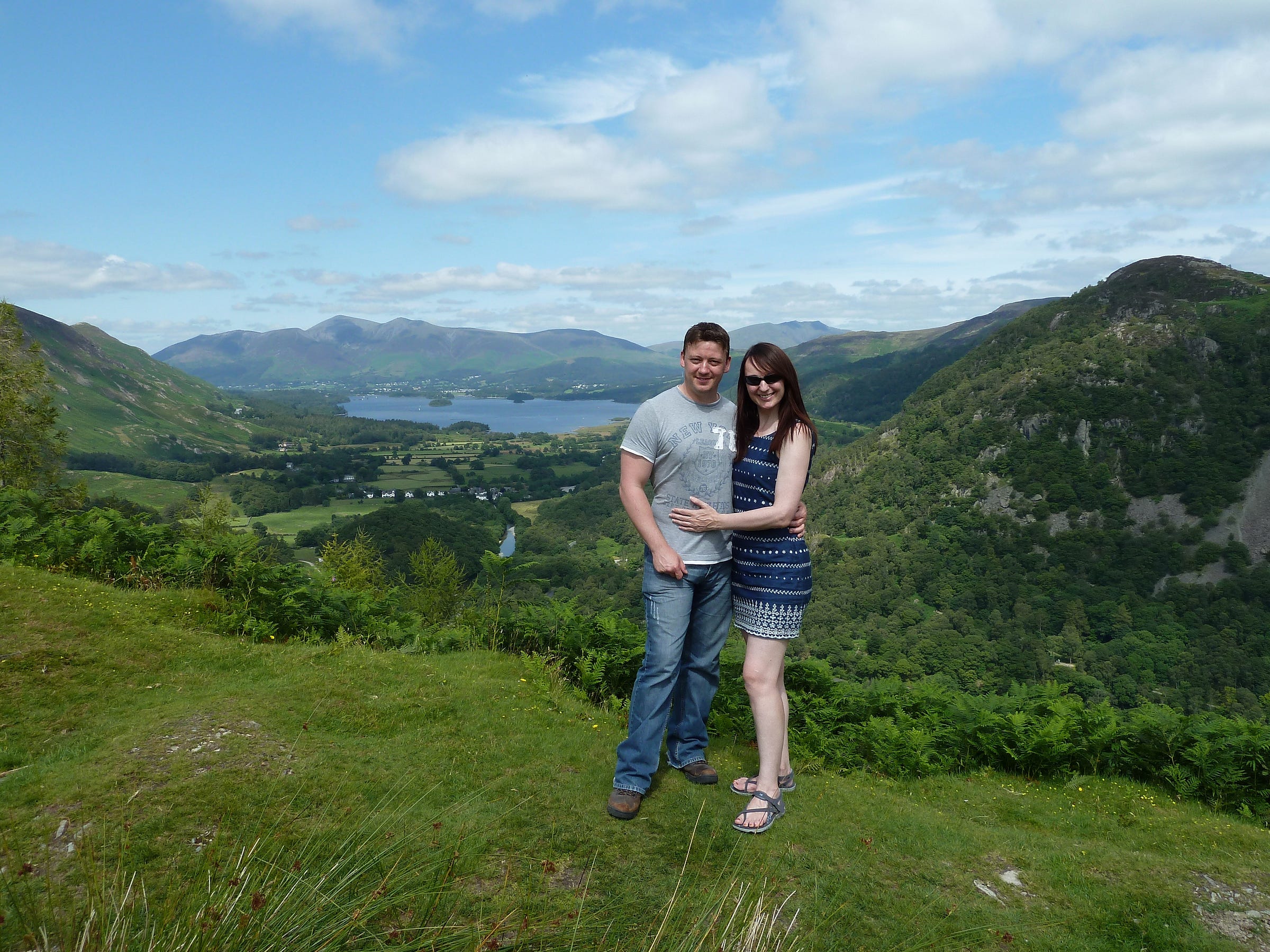
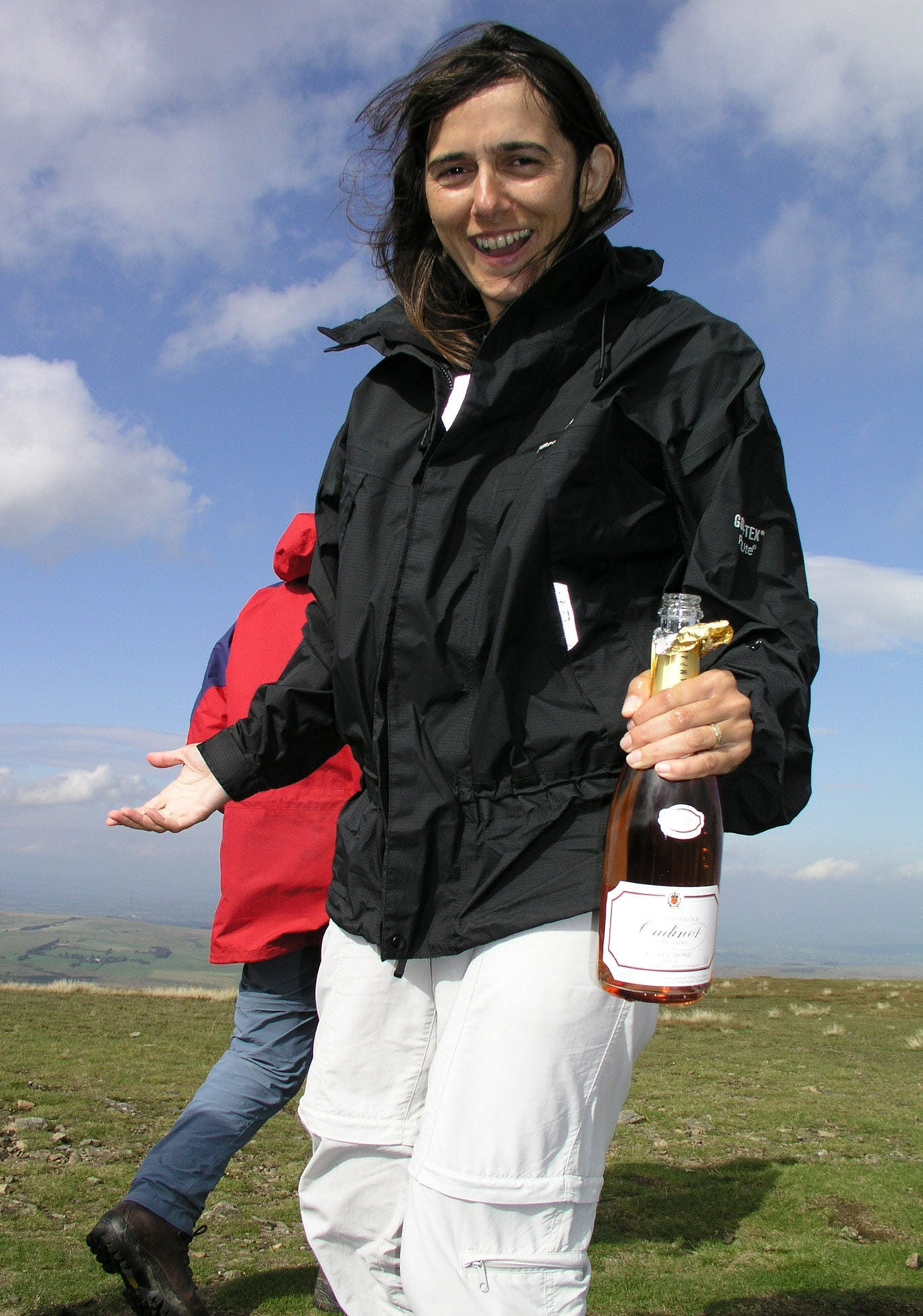
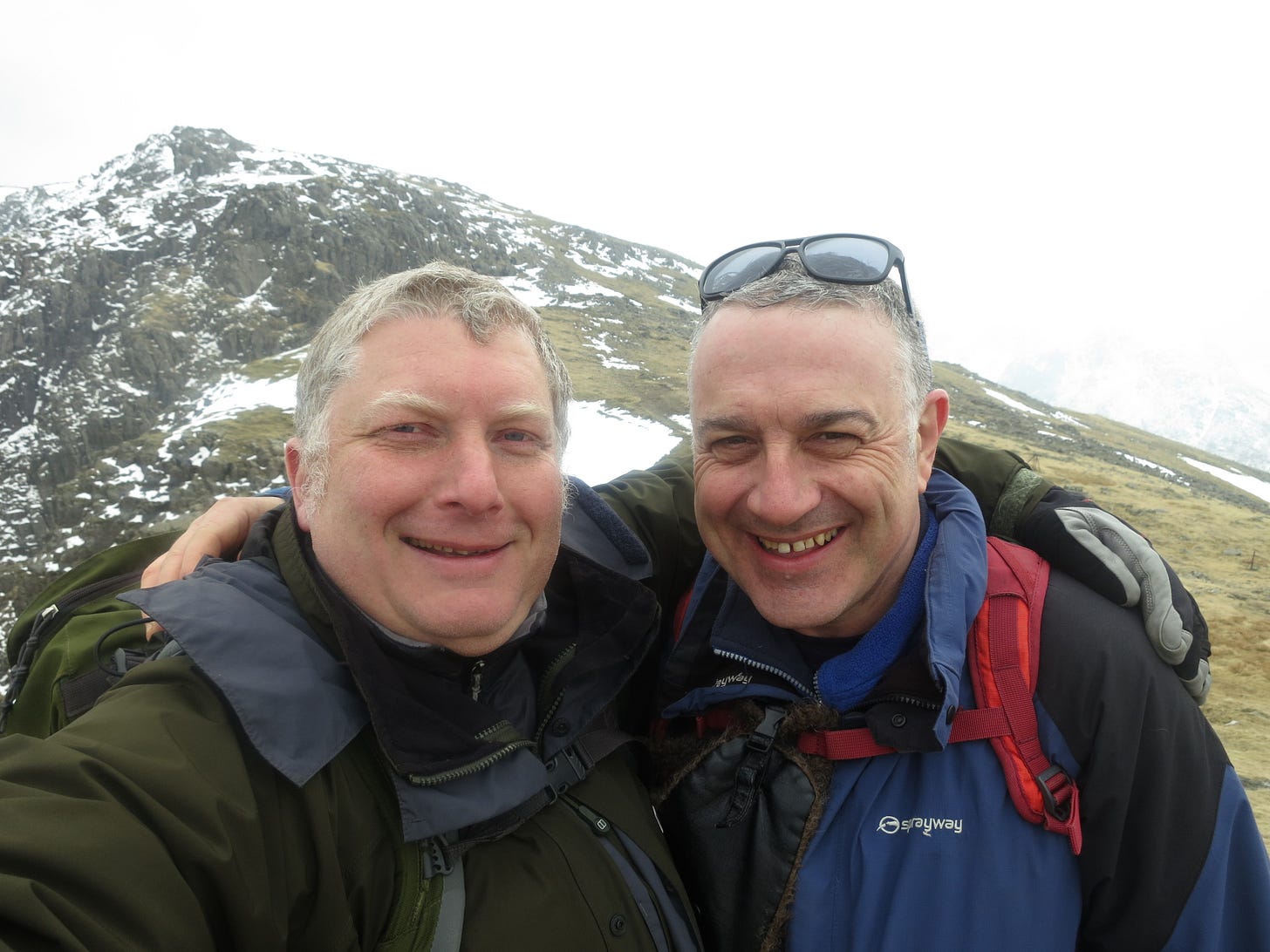
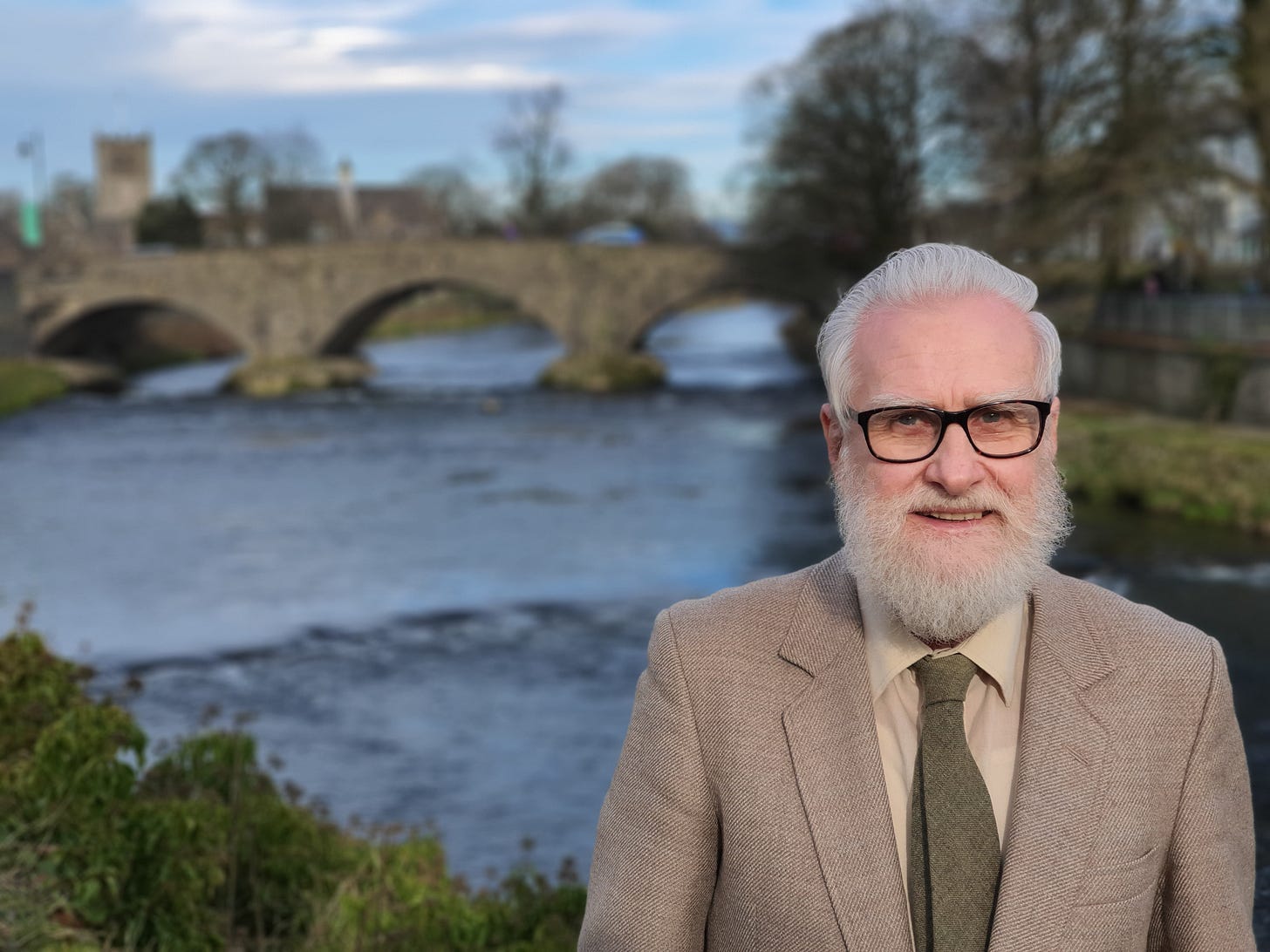
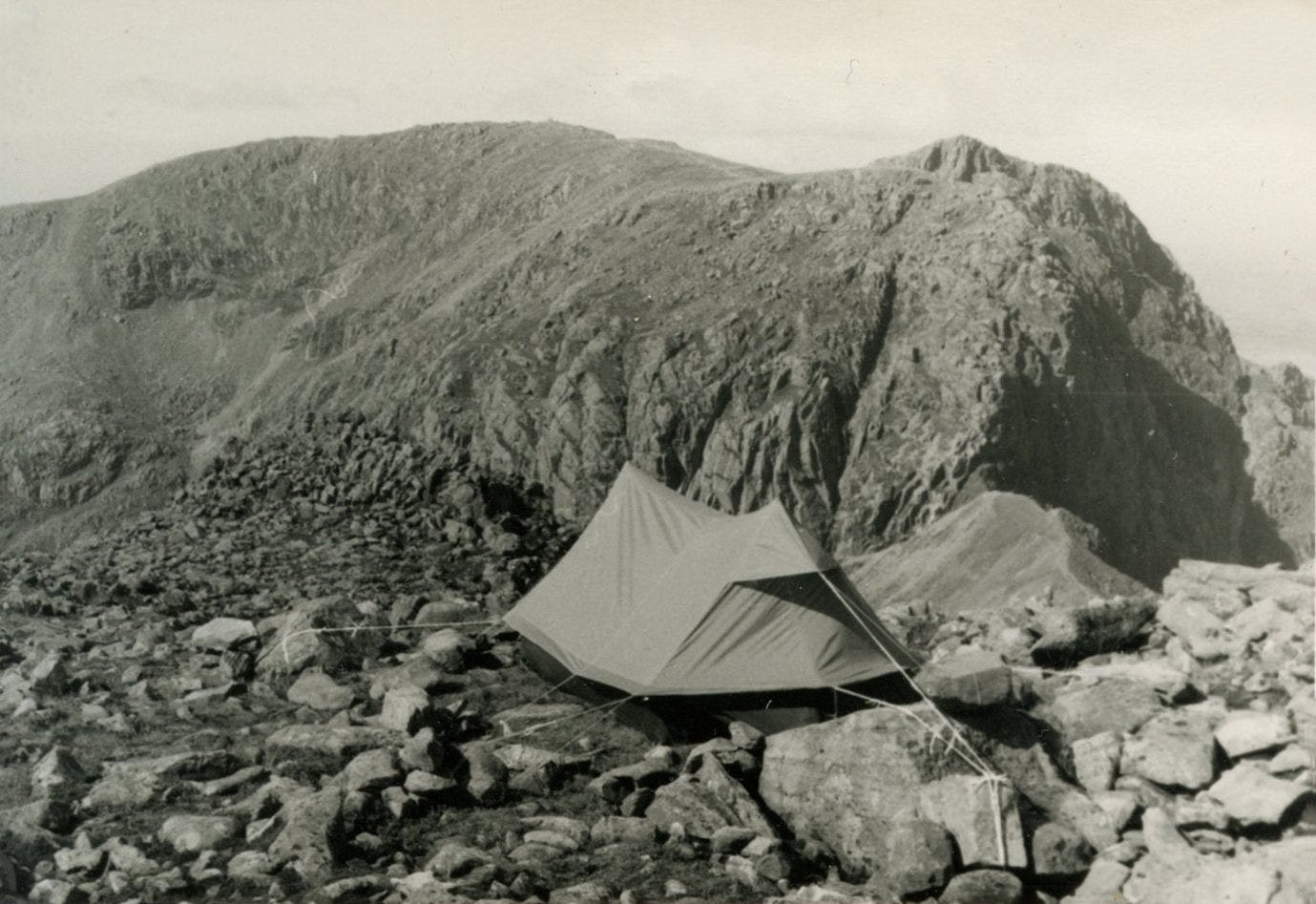
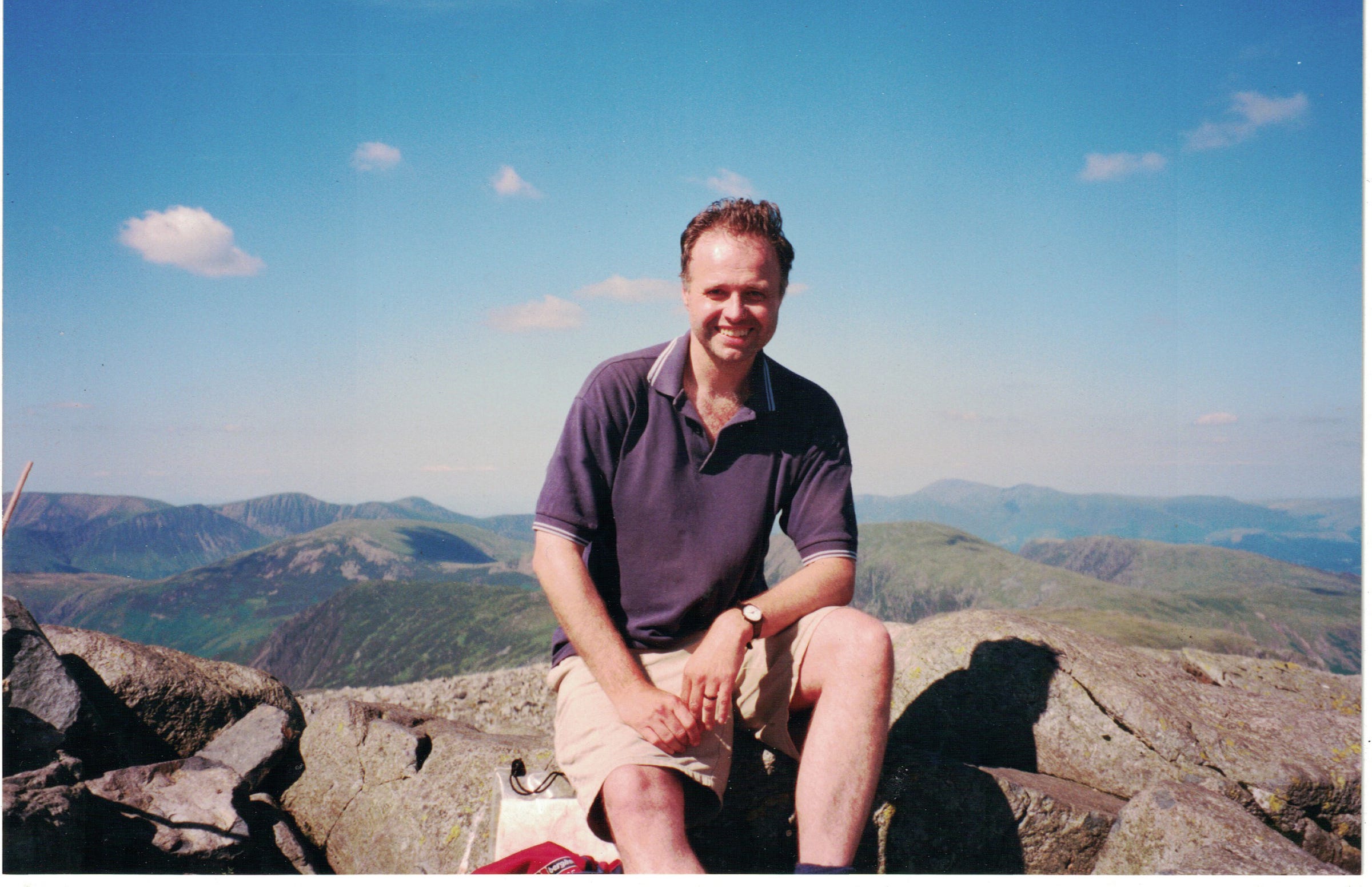
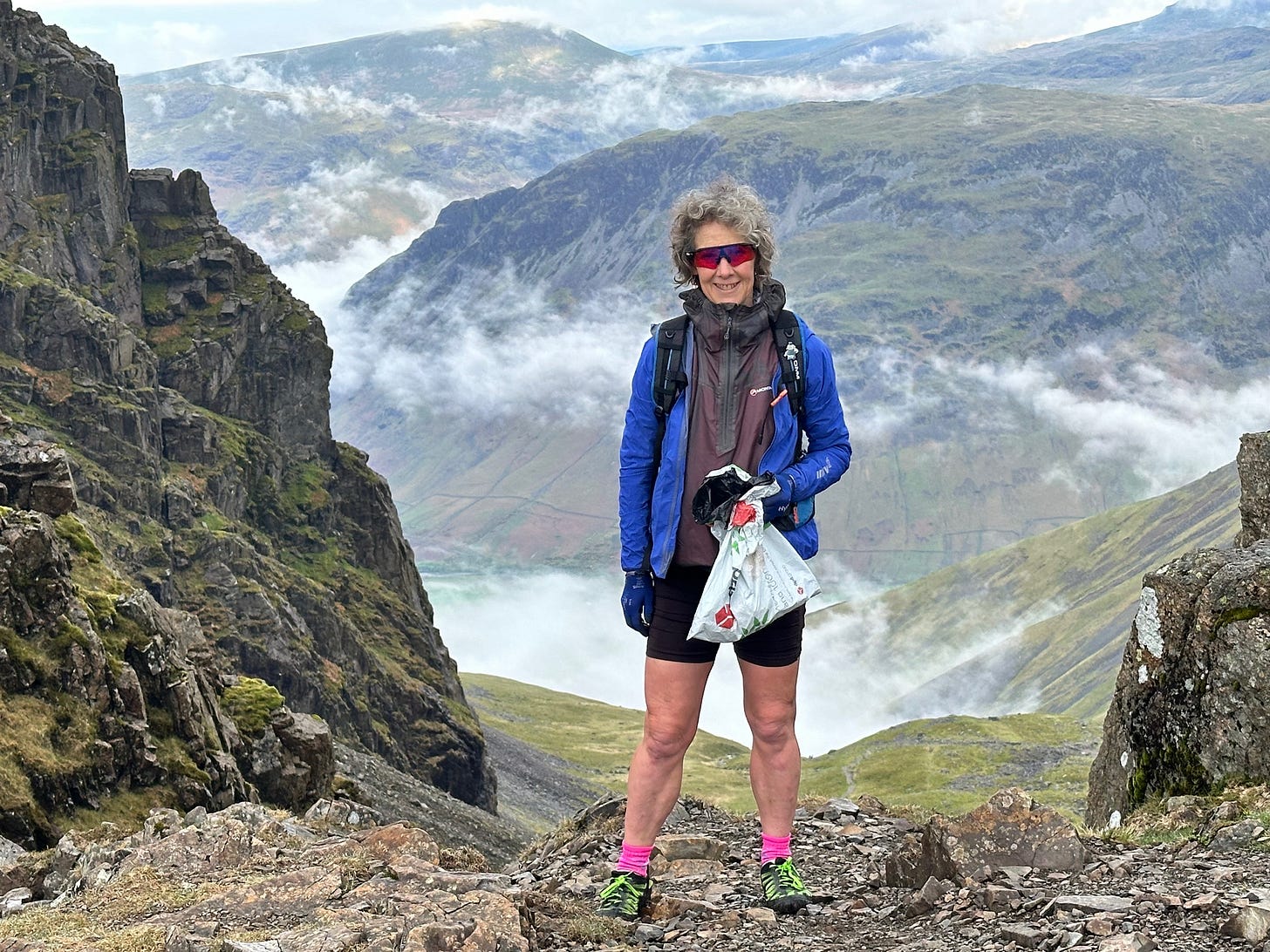
Thanks Rachael.
A truly brilliant, profound read. We never know what stories are behind photos of people. In a depressing time in this world it’s so inspiring to know that there are good people just doing good things. Thank you. I will treasure this article.